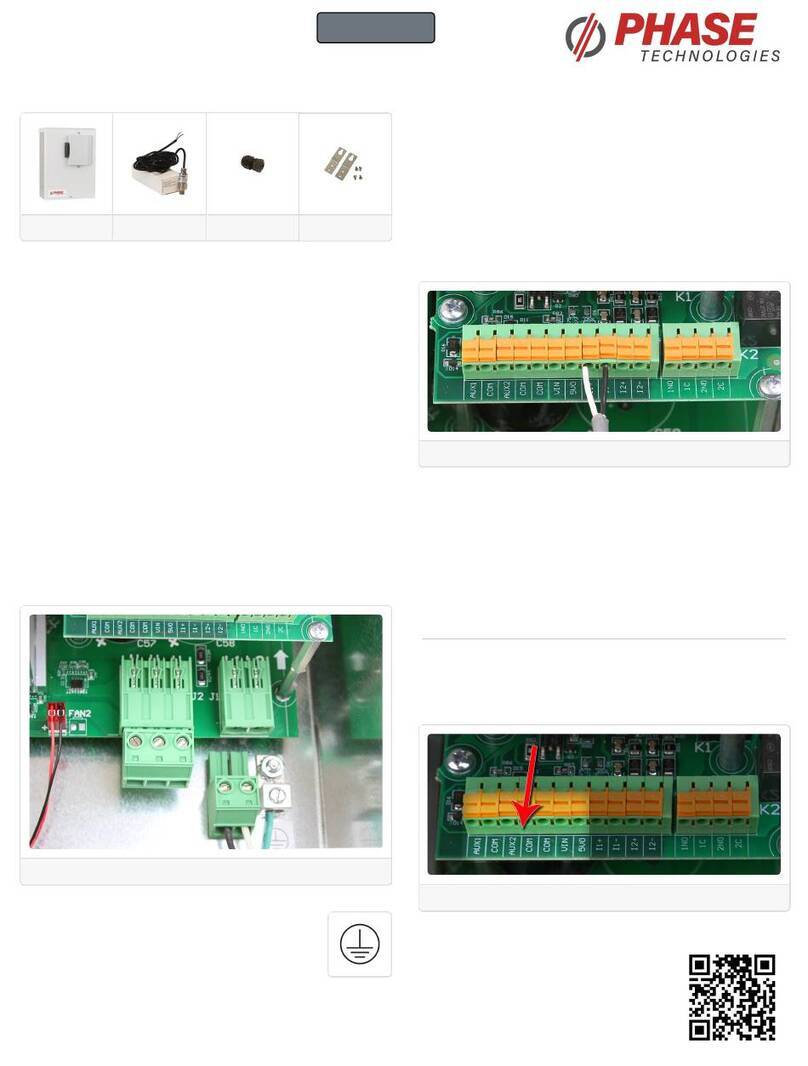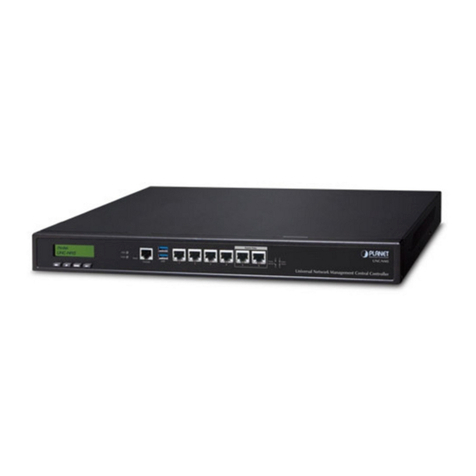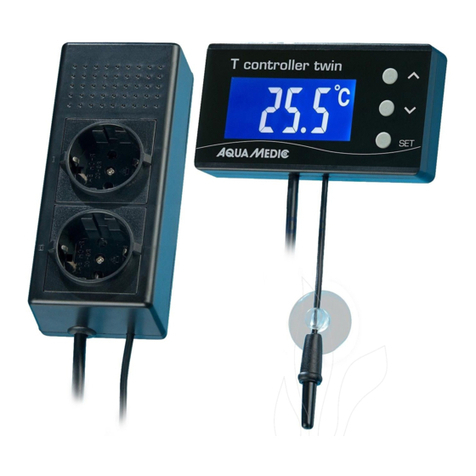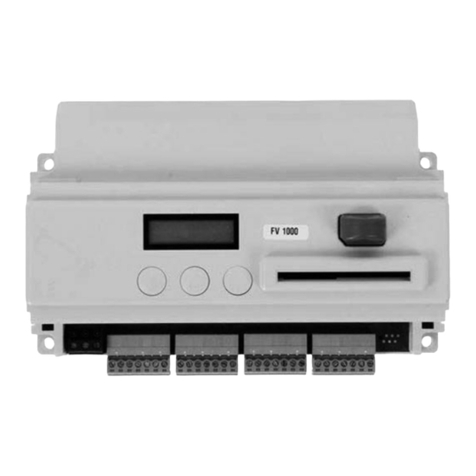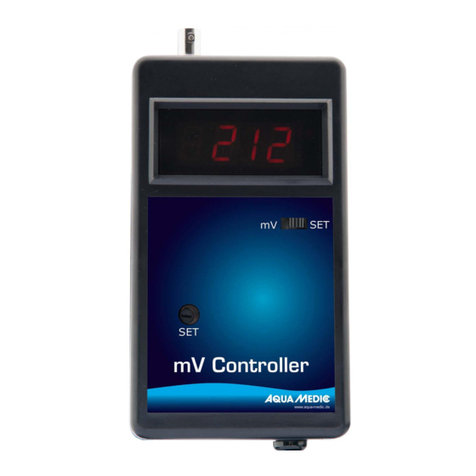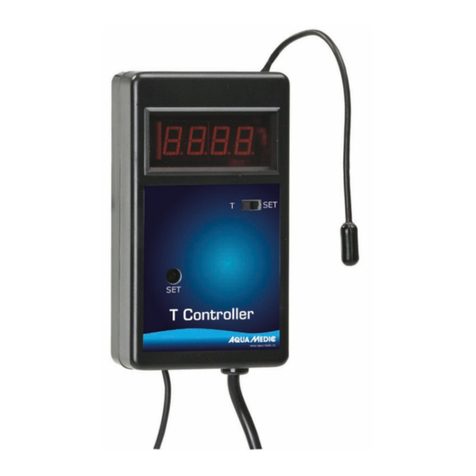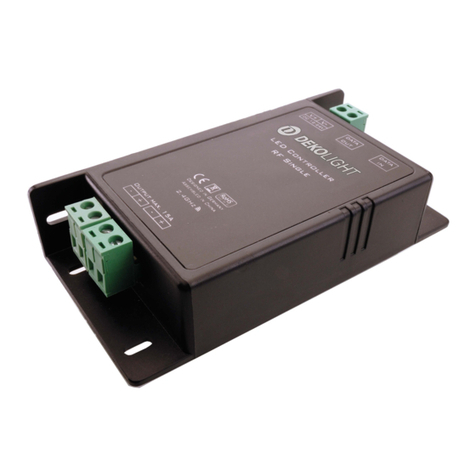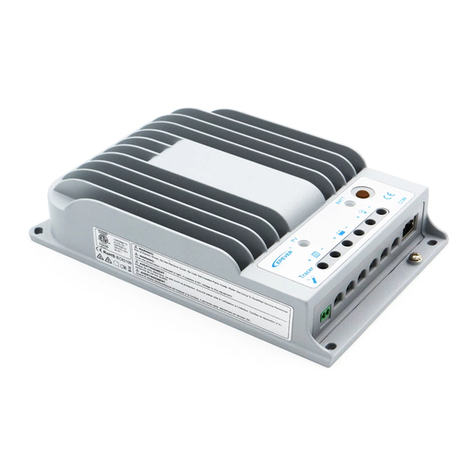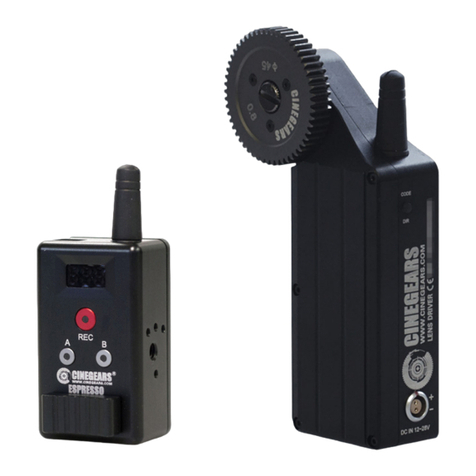SIPOS AKTORIK SIPOS 5 User manual

Operation
instructions
Electric actuators
SIPOS 5
PROFITRON
HiMod
Issue 10.16 Y070.020/GB
Subject to changes without notice!

Operation instructions
SIPOS 5 PROFITRON, HiMod
Page 2 Y070.020/GB
Contents
Contents
1 General information ............................ 3
1.1 Safety information ................................. 3
1.2 Transport and storage ........................... 4
1.3 Disposal and recycling .......................... 4
1.4 Notes to the operation instructions ........ 4
1.5 Supplementary operation instructions ... 5
2 General................................................. 6
2.1 Functional principle ............................... 6
2.2 Sub-assemblies ..................................... 7
2.3 Block diagram (electrical connections) .. 8
3 Assembly and connection.................. 9
3.1 Mounting to valve/gear .......................... 9
3.2 Electrical connection ........................... 10
3.3 Separate mounting .............................. 14
4 Instructions on operator control
and operation..................................... 15
4.1 Crank handle, hand wheel ................... 15
4.2 Local control station, display ............... 16
4.3 Main menu, menu control .................... 18
4.4 Remote control .................................... 20
4.5 COM-SIPOS ........................................ 21
5 Commissioning ................................. 22
5.1 General information ............................. 22
5.2 Selecting the language ........................ 23
5.3 Accessing the „commissioning“
menu; access authorization ................. 24
5.4 Programming closing direction,
speeds, cut-off modes and tripping
torques ................................................ 25
5.5 Other valve-specific parameters ......... 29
5.6 End positions adjustment for version
with signaling gear ............................... 31
5.7 End position adjustment for HiMod
and PROFITRON in „non-intrusive“
version ................................................. 39
6 Parameters and possible
parameter values............................... 44
6.1 Valve-specific parameters ................... 44
6.2 Control system parameters ................. 46
6.3 Optional software functions ................ 54
7 Status and fault signals,
diagnosis............................................ 55
7.1 Observing (device state and
fault signals) ........................................ 55
7.2 Status and fault signals ...................... 58
7.3 Diagnosis (operational data and
maintenance limits) ............................. 61
7.4 Recording the torque curves ............... 62
8 Maintenance, inspection, service .... 64
8.1 General ................................................ 64
8.2 Lubrication intervals and lubricants ..... 65
9 Spare parts......................................... 66
9.1 General ................................................ 66
9.2 Spare parts list .................................... 66
9.3 Exploded views ................................... 67
EU Declaration of Conformity /
Declaration of Incorporation in compli-
ance with Machinery Directive..............79

Y070.020/GB Page 3
Operation instructions
SIPOS 5 PROFITRON, HiMod
1
General information
1 General information
1 General information
1.1 Safety information
General
The devices referred to in this document applies are components of installations conceived for
industrial applications. They are designed in accordance with the recognized engineering rules.
All work involved in transport, assembly, installation, commissioning, maintenance and repair has to
be performed by qualified personnel.
Qualified personnel within the meaning of the safety instructions of this documentation are all
persons authorized to perform the required tasks according to the standards of safety technology
and which may recognize and avoid potential hazards. They must be thoroughly familiar with the
warnings at the device and the safety instructions of these operation instructions.
For work on power installations, the prohibition of the use of non-qualified persons or similar is
stipulated in EN 50110-1 (formerly DIN VDE 0105) or IEC 60364-4-47 (VDE 0100 part 470).
Correct transport, proper storage, mounting and installation, as well as careful commissioning are
essential to ensure a trouble-free and safe operation.
The availability of this product is restricted according to IEC 61800-3 and may cause radio interfe-
rences in domestic environments. In this case it may be necessary to take additional measures.
■Leakage
The leakage current of the actuators is typically greater than 3.5 mA. Therefore a fixed installati-
on according to IEC 61800-5-1 is required.
■Residual current circuit breakers or monitoring devices
Due to the integrated frequency inverter, a direct current can be induced in the protective
earthing conductor. If the network an upstream residual current device (RCD) or residual current
monitor (RCM) is used, then it must be of type B.
The following is of particular importance:
■the technical data and information concerning the proper use (installation, connection, ambient
and operating conditions) provided in the catalog, order documents, operation instructions, rating
plate data and in the other product documentation;
■the general installation and safety guidelines;
■the local plant-specific regulations and requirements;
■the local environmental conditions, in particular the repeated load which might result when moun-
ting the actuator to a vibrating valve.
■the proper use of tools, lifting and transport equipment;
■the use of personal protective equipment, especially in high ambient temperatures and with high
actuator surface temperatures (caused by frequent and long activation times).
Warnings on the device
Danger of crushing. When pressing in the crank hand-
le or the handwheel ensure that neither the hand nor
the fingers are crushed, refer to figure.
Applicable for devices of the 2SA5.5/6/7/8 and
2SB555/6 series. Indicates the lubricant used. Refer
also to chapter 8.2 “Lubrication intervals and lubri-
cants“.
Fig.: Danger of crushing

Operation instructions
SIPOS 5 PROFITRON, HiMod
Page 4 Y070.020/GB
1 General information
1
General information
1.3 Disposal and recycling
Packaging
The packaging of our products consists of environmentally friendly materials which can easily be
separated and recycled. We use following packaging materials: Wood-based panels (MSB/OSB),
cardboard, paper, PE foil. For the disposal of the packaging material, we recommend recycling and
collection centers.
Actuator
Our actuators have a modular design and may therefore be easily disassembled, separated and
sorted according to materials, i.e.: electronic parts, different metals, plastics, greases and oils.
The following generally applies:
■Collect greases and oils during disassembly. As a rule, these are substances hazardous to water
and must not be released into the environment.
■Arrange for controlled waste disposal of the disassembled material or for separate recycling
according to materials.
■Observe the national/local regulations for waste disposal.
1.4 Notes to the operation instructions
1.4.1 Safety instructions: Used symbols and their meanings
The following symbols, which have different meanings, are used in the operation instructions. Non-
observance may lead to serious injuries or property damage.
Warning marks activities which, if not carried out correctly, can affect the safety of persons or
property.
Notice marks activities which have major influence on the correct operation. Non-observance of
these notes may lead to consequential damage.
Electrostatically endangered are located on circuit boards, which may be damaged or des-
troyed by electrostatic discharges. If the boards need to be touched during setting, measurement
or for exchange, it must be assured that immediately before touching an electrostatic discharge
through contact with an earthed metallic surface (e.g. the housing) has taken place.
Procedure may have been performed by valve manufacturer:
If actuators are delivered mounted to a valve, this step has been done in the valve manufacturer’s
factory. The setting has to be checked during commissioning.
1.2 Transport and storage
■The dispatch must be performed in sturdy packaging.
■For transport, loop the rope around the motor and the hand
wheel housing, refer to illustration. Only use the eyes (1) on
the electronic unit to lift the actuator‘s own weight.
■Do not attach the ropes and hooks at the crank handle or
hand wheel for the purpose of lifting.
■Store in well-ventilated, dry room.
■Protect against damp floors by storing on a shelf or pallet.
■Keep connection hood/cover and cable glands as well as the
cover of the electronic unit closed.
Fig.: Transport

Y070.020/GB Page 5
Operation instructions
SIPOS 5 PROFITRON, HiMod
1
General information
1 General information
1.4.2 Scope
For the sake of clarity, not all details of all versions of the product are described in these operation
instructions, nor can they cover all conceivable cases regarding installation, operation and mainte-
nance. For this reason, the operation instructions only contain instructions for qualified personnel
(refer to section 1.1) that are necessary when the equipment is used for the purpose for which it is
intended or in industrial applications.
If the devices are used in non-industrial applications with increased safety requirements, they have
to be ensured by additional safety measures during assembly.
In case of any questions, and especially where detailed product information is not available, contact
the SIPOS Aktorik sales representative in charge. Always state the type designation and the works
number of the respective actuator (see rating plate).
It is recommended that the services and support of the responsible SIPOS Aktorik service centers
are utilized for all planning, installation, commissioning and service task.
The contents of these operation instructions and product documentation shall not become part of or
modify any prior or existing agreement, commitment or legal relationship. The Purchase Agreement
contains the complete and exclusive regulation on material defect liability of SIPOS Aktorik. These
contractual regulations are neither amended nor limited by the descriptions contained in these ope-
ration instructions and documentation.
1.5 Supplementary operation instructions
2SB5 linear actuator Y070.027
2SC5 part-turn actuator Y070.028
2SG5 small part-turn actuator Y070.029
COM-SIPOS computer parameterization software Y070.024
PROFIBUS operation instructions Y070.023
MODBUS operation instructions Y070.022
HART instructions Y070.221
Enclosure protection IP68 „K51“ Y070.047
Increased vibration resistance „K57“, „K58“ Y070.048
Increased vibration resistance according to seismic class S2A „K59“ Y070.049
Very high corrosion protection
corrosivity category C5 with long protection time „L38“ Y070.162
SIPOS 5 actuator with USP Y070.053
Binary and analog inputs freely available via bus Y070.050
Optional software functions See chapter 6.3
Short instructions PROFITRON Y070.021
and others
Any special installation and operation instructions furnished by the suppliers of subcontracted com-
ponents, attachments or fixtures are attached to the set of instructions and have to be observed.

Operation instructions
SIPOS 5 PROFITRON, HiMod
Page 6 Y070.020/GB
2 General
2
General
2 General
2.1 Functional principle
Description
The electronics with integral frequency converter (1) controls the motor (2). The motor turns the
output drive shaft (4) via the worm shaft (3). The output drive shaft (4) drives a gear or a valve stem
(5) via a stem nut.
The motion of the worm shaft (3) is transferred via the signaling shaft (6) to.
■the signaling gear (7a). The signaling gear reduces the movement and turns the potentiometer or
the magnetic travel sensor (8).
or:
■the non-intrusive position encoder (niP) (7b) for „non intrusive“ version. The non-intrusive position
encoder counts the number of rotations. The position recording is also performed without external
power supply.
From the position of the potentiometer or the non-intrusive position encoder, the electronics recog-
nizes the position of the output shaft (9) and therefore the position of the operated valve. The motor
is controlled according to the process requirements.
The torque detection (DE) is performed electronically.
Fig.: Functional principle

Y070.020/GB Page 7
Operation instructions
SIPOS 5 PROFITRON, HiMod
2
General
2 General
2.2 Sub-assemblies
The actuators of the SIPOS 5-Series comprise
two main assemblies: gear unit and electronics
unit.
For details see chapter 9. „Spare parts“.
The main sub-assembly gear consists
of the sub-assemblies:
1 Plug element electronic connection,
2 Motor,
3 Gear unit,
4 Signaling gear or non-intrusive position enco-
der (not for 2SG5) with cover,
5 Manual drive (with crank or hand wheel),
6 Possible mechanical extensions, depending
on the version,
For the small 2SG5 part-turn actuator, the
signaling gear is omitted; gear unit and manual
drive have a different shape.
The main sub-assembly electronics unit
consists of the sub-assemblies:
1 Electrical connection (there are three versi-
ons),
2 Plug element gear connection,
3 Electronic housing with cover,
4 Power control PCB, including Power module,
Fig.: Sub-assemblies gear
Fig.: Sub-assemblies electronics unit
5 Fieldbus board (option) or
6 Relay board (option),
7 Control board ,
8 Bluetooth module (option).

Operation instructions
SIPOS 5 PROFITRON, HiMod
Page 8 Y070.020/GB
2 General
2
General
2.3 Block diagram (electrical connections)
The block diagram shows the electronic sub-assemblies and the inputs and outputs for possible
customer-specific connections.
Fig.: Block diagram

Y070.020/GB Page 9
Operation instructions
SIPOS 5 PROFITRON, HiMod
3
Assembly and connection
3 Assembly and connection
3 Assembly and connection
3.1 Mounting to valve/gear
If actuators are delivered mounted to a valve, this step has been done in the valve manufacturer’s
factory. However, the setting has to be checked during commissioning.
■Please pay attention to the safety information (see chapter 1.1)!
■Before starting the assembly, please make sure that the intended measures (possible operation
of the valve, etc.) is not likely to cause any injuries to persons or to interfere with the equipment.
It is recommended that the services and support of the responsible SIPOS Aktorik service centers
are utilized for all planning, installation, commissioning and service task.
3.1.1 General assembly instructions for all output shaft versions
■Mounting and operation is possible in any position.
■Avoid all shocks; do not attempt to use force.
■Check that the end connection flange and the output shaft type match the valve/gear.
■Thoroughly degrease mounting faces at actuator and valve/gear.
■Slightly grease the connection points.
■Place the actuator on the valve/gear, making sure it is properly centered.
■Use bolts with at least 8.8 quality. If other similar, stainless steel bolts are used, they should be
greased slightly with petroleum jelly.
The depth of engagement should be at least 1.25 x the thread diameter.
■Position the actuator on the valve/gear and tighten the bolts evenly in diagonally opposite se-
quence.
■The housing of the SIPOS 5 actuators consists of an aluminum alloy which is corrosion resistant
under normal environmental conditions. If the paint was damaged during assembly, it can be
touched up with original paint supplied in small quantity units by SIPOS Aktorik.
3.1.2 Output shaft type A
Assembly instruction
The stem nut is screwed onto the valve stem by turning the
crank handle or the hand wheel.
Fitting and removing the stem nut
If the stem nut was not ordered with a trapezoidal thread (suffix
„Y18“ to ordering number), or if the stem nut is worn and has to
be replaced, proceed as follows:
Output flange (fig., item 1) does not have to be removed
from the rotary actuator!
1. Unscrew centering ring (fig., item 5) from output flange.
2. Take off stem nut (4) together with axial needle-roller assem-
bly and axial bearing washers (3).
3. Remove the axial needle-roller assembly and the axial bea-
ring washers (3) from the stem nut.
4. Only if the stem nut was delivered without thread: Machine
a thread in the stem nut (4) (check the concentricity and the
axial run-out when it is clamped) and clean it. Fig.: Output shaft type A
assembly

Operation instructions
SIPOS 5 PROFITRON, HiMod
Page 10 Y070.020/GB
3 Assembly and connection
3
Assembly and connection
5. Lubricate axial needle-roller bearings and axial
bearing washers (3) with ball bearing grease and
fit them on the new or machined stem nut (4).
6. Insert stem nut (4) with axial needle-roller as-
sembly into output flange (claws have to engage
properly into the groove of the output shaft of the
actuator).
7. Screw in the centering ring (5) and tighten it as
far as the stop.
Make sure the radial seal is inserted correctly (6).
8. Using a grease gun, press ball bearing grease
into the grease nipple (2) until lubricant is dischar-
ged between the centering ring (5) and the stem
nut (4).
3.1.3 Mount spindle protection tube
1.Remove fastener (fig., item 1).
2.Check that the extended stem does not exceed
the length of the protective tube.
3.Apply sealing compound to the thread and the
sealing faces (e.g. 732 RTV from Dow Corning,
Munich, Germany).
4.Screw in the spindle protection tube (2).
Fig.: Output shaft type A installed
Fig.: Mounting the spindle protection
tube
3.2 Electrical connection
The components are designed as to ensure that once connected correctly, uninsulated, live parts
cannot be touched directly; i.e. protection against electric shock is provided in accordance with
IP2X or IPXXB.
Dangerous voltages are also present when the motor is at a standstill. Before opening the
terminal cover or the connection hood, disconnect the supply voltage from the actuator. Allow 5
minutes for the capacitors to discharge and do not touch any contacts.
■The supply voltage must always lie within the voltage range specified on the rating plate.
■Mains cable: Use metal cable glands for mains connection.
■Signal cable: Use metal cable glands with cable shielding for the connection of the control
cable to avoid the occurrence of electronic faults. The signal cable must be shielded and the
shield must be fixed or earthed on both sides. Ensure careful connection of the screen within
the cable gland!
■It must be ensured that the cable glands and seals (O-rings) are fitted carefully and correctly
in order to guarantee the enclosure protection. For details of the permissible conductor cross-
sections, see wiring diagram.
■Cable glands and cables are not included in the scope of delivery.

Y070.020/GB Page 11
Operation instructions
SIPOS 5 PROFITRON, HiMod
3
Assembly and connection
3 Assembly and connection
3.2.1 Direct connection
Fig.: Direct connection
Highly sensitive CMOS semiconductor components extremely sensitive to static electricity are
mounted on the printed circuit boards. Avoid touching tracks or components on the boards with
the fingers and prevent tracks or components coming into contact with metal objects. Only the
screws of the terminal blocks may be touched in order to make the connections and only with an
insulated screw driver.
1. Unscrew connection hood (fig., item 1) and cover for electronic housing (7).
2. Unscrew screw plugs from the required cable glands in the connection hood.
3. Screw in the cable glands (2) only slightly and insert the connecting cables.
4. Take off terminal plug X1 (4) from the power control PCB and terminal plugs X3.1, X3.2 (6) from
the control board. If a relay board is used, then remove terminal plugs X2.1, X2.2 (5). If required,
use a screw driver to carefully eject the plugs from the sockets.
5. Connect the connecting cables in accordance with the circuit diagram enclosed in the connection
hood, connecting the earth lead conductor to the provided terminal in the connection box.
6. Reconnect all terminal plugs.
7. Fit connection hood (1) and cover for electronic housing (7) again.
8. Tighten cable glands (2).

Operation instructions
SIPOS 5 PROFITRON, HiMod
Page 12 Y070.020/GB
3 Assembly and connection
3
Assembly and connection
3.2.2 Connection with round plug
1.Unscrew connection hood (fig., item 2) with
plug element (1).
2.Unscrew screw plugs from the required cable
glands in the connection hood.
3.Unscrew plug element (1) from connection
housing (2).
4.Screw in the cable glands (3) only slightly and
insert the connecting cables (4).
5.Connect the connecting cables in accordance
with the circuit diagram enclosed in the con-
nection hood, connecting the earth lead to the
provided terminal in the connection box.
6.Screw plug element (1) into the connection
hood (2) and then fix connection hood.
7.Tighten cable glands (3).
3.2.3 Fieldbus connection
1. Dismantle fieldbus connection housing (fig.
item 2) and connection cover (4).
2. Unscrew plug element (1) from fieldbus
housing (2).
3. Unscrew screw plugs only from the required
cable glands of the fieldbus housing.
4. Screw in the cable glands (5) only slightly and
insert the connecting cables (6).
For fieldbus cables, cable glands without
shield are sufficient, refer to point 7 below.
5. Connect the mains cables and, if required,
signal cables in accordance with the circuit
diagram enclosed in the connection hood,
connecting the earth lead conductor to the
provided terminal in the connection box.
6. Fit plug element (1) into fieldbus housing (2)
again.
7. Connect fieldbus connecting cables to the bus
termination PCB (3). Lead shielding (7) under
metal clamp (8).
8. Fit connection cover (4) and fieldbus housing
(2) again.
9. Tighten cable glands (5).
a = If the actuator is the last device of the bus
segment, the termination resistor must be set
to ON or a termination must be done exter-
nally.
b = Connection for external 24 V power supply.
Enables communication even if the mains are
disconnected.
c = Connection for PROFIBUS DP bus motor
(protcol analyzer).
Fig.: Connection with round plug
Fig.: Fieldbus connection

Y070.020/GB Page 13
Operation instructions
SIPOS 5 PROFITRON, HiMod
3
Assembly and connection
3 Assembly and connection
Fig.: Connection with galvanic separation
Fig.: Fitting the potential conductor
3.2.4 Connection with galvanic separation
Binary inputs and outputs are galvanically separated via opto-couplers. Analog signals can be
galvanically separated as an option. This is required to avoid overlapping currents and voltages by
means of equalization potentials.
■Actual position value (analog output) galvanically separated: Add. version C10.
■Actual position value (analog output) and position setpoint (analog input) galvanically separated.
Add. version C11.
1. Unscrew fieldbus connection housing (fig.,
item 2) and connection cover (4).
2. Unscrew plug element (1) from connection
housing (2).
3. Unscrew screw plugs from the required cable
glands in the connection hood.
4. Screw in the cable glands (5) only slightly and
insert the connecting cables (6).
5. Connect the connecting cables in accordance
with the circuit diagram enclosed in the con-
nection hood, connecting the earth lead to the
provided terminal in the connection box.
Connect the wire for analog signals „actual po-
sition value“ and, if required, „position setpoint“
to the connection board (3). Lead shielding
under the metal clamp.
6. Screw plug element (1) into connection
housing (2).
7. Fit connection housing (2) and connection
cover (4) again.
8. Tighten cable glands (5).
3.2.5 External potential conductor connection
The external potential conductor connection can be used for functional grounding and not for pro-
tective grounding.
1. Remove plastic fastener (1) from the electronic
housing.
2. Fit potential conductor (4) and gripping disc (3)
with M5 screw (2).

Operation instructions
SIPOS 5 PROFITRON, HiMod
Page 14 Y070.020/GB
3 Assembly and connection
3
Assembly and connection
3.3 Separate mounting
If the ambient conditions such as extreme vibra-
tion, high temperature and/or if access is difficult,
the electronics unit is to be mounted separately
from the gear.
The assembly kit for mounting the gear unit and
electronics unit separately can be ordered directly
with the actuator or separately as an accessory
(2SX5300-.GA..). The assembly kit is preassem-
bled. If the assembly kit is ordered directly with the
actuator, it is included separately with the actuator.
The assembly kit is also available with a cable
separation system with quick disconnect couplers.
For installation in separate rooms, a wall bushing
of only Ø 45 mm is required.
Before starting the work, disconnect actuator
from the mains!
Procedure
1. Install mounting bracket (fig., item 3) at the
mounting location of the electronics unit.
2. Remove electronic housing (1) from the gear
unit (6) and mount it on the mounting bracket
(3) with the O-ring (2).
3. Standard assembly, refer to A
Mount „Separate mounting“ kit: Plug cover with
contact pins (4) on lower side of wall bracket (3)
and plug cover with contact sockets (5) on the
gear unit (6).
4. Assembly with spindle protection tube,
refer to B
Turn connection hood by 90° or 180° to ensure
cables are not impaired by the spindle protec-
tion tube. Remove screws (7) from round plug,
turn round plug by 90° to 180° and fix screws
again. Continue as described in section 3.
■During installation, it is important to ensure that the O-rings are fitted correctly in order to gua-
rantee the degree of protection.
■Generally, it has to be ensured that movable parts, e.g those of the swing lever, are not im-
paired by the cables.
■In exceptional cases, the motor might become very hot. Therefore the cables should not touch
the motor.
Specification of the connecting cable between the electronics unit and the gear
unit
Power supply: Shielded and UV resistant, e.g. Topflex-611-C-Pur-4G1.5/11.3 cable.
(TOPFLEX® is a trade mark of HELUKABEL.)
Control connection: shielded and UV resistant, e.g. L IY11Y-7x2x0.5/11.4-S.
The crimp contacts are silver plated.
The connecting cables are available in different versions:
■Standard lengths: 3 m; 5 m; 10 m,
■with additional device (filter) up to 50 m
(if separate mounting of more than 10 m with filter, the „Sep. mounting“ parameter must be set to
value „>10m with filter“).
Fig.: Separate mounting
A = Standard, B = with spindle protection tube

Y070.020/GB Page 15
Operation instructions
SIPOS 5 PROFITRON, HiMod
4
Instructions on operator control and operation
4 Instructions on operator control and operation
4 Instructions on operator control and
operation
4.1 Crank handle, hand wheel
■Motor driven operation of the crank handle/hand wheel is not permitted.
■After commissioning, the actuator must not be operated beyond the parameterized end posi-
tions using the crank handle/hand wheel.
■When pressing in the crank handle/ the hand wheel, make sure that the hand is not between
the crank handle/the hand wheel and the housing: Danger of crushing! See the following opera-
tion step 3.
During motor operation the crank handle/the hand
wheel does not turn.
Operation
Operation of all actuators except for 2SG5:
1. The actuator must be at standstill (1).
2. Remove the clamp (option) (2). The clamp is used
as protection against accidental engaging of the
crank handle/the hand wheel, if the actuator is expo-
sed to heavy vibration or water pressure (enclosure
protection IP 68).
3. Press crank handle/hand wheel in direction of the
gear housing against the spring force (3) and turn
(4). (Caution: Danger of crushing when engaging!)
The hand wheel has priority over motorized operation. The actuator can only be operated electri-
cally once the crank handle/hand wheel is released.
If the actuator is operated manually in the „Remote“ state and an operation command is present,
the actuator is immediately operated after releasing the crank handle.
Only for 2SG5:
Turn hand wheel without pressing it in. Manual operation interferes with motor operation: If the hand
wheel is turned during motor operation, the positioning time is either extended or reduced, depen-
ding on the direction of rotation.
Direction of rotation
Clockwise turning of the crank handle/hand wheel leads to
■2SA5 rotary actuator: Clockwise rotation of the output drive shaft (exception: 2SA5.7. and
2SA5.8.).
■2SB5 linear actuator: Extension of the thrust rod.
■2SC5 part-turn actuator: With view on the pointer cover of the worm gearbox: clockwise move-
ment of the coupling or lever arm with the worm gearbox versions RR or LR.
■2SG5 part-turn actuator: With view on the mechanical position indicator: clockwise rotation at the
coupling or at the swing lever.
Fig.: Operating the crank handle

Operation instructions
SIPOS 5 PROFITRON, HiMod
Page 16 Y070.020/GB
4 Instructions on operator control and operation
4
Instructions on operator control and operation
4.2 Local control station, display
On local control station, the operation can be made directly at the actuator via 4 push buttons (refer
to fig. Local control panel).
By repeatedly pressing the Local/Remote button, you may change between the three states „Remo-
te“, „Local“ and „locPar“.
Depending on the state the actuator is in, the push buttons have different functions.
If you switch from the „Local“ or „locPar“ to the „Remote“ state, the actuator runs, if there is an
operation command present from the automation system.
The COM-SIPOS parameterization program enables convenient operation and parameterization
of the actuator, refer to chapter 4.5. The actuator can be controlled from the computer (laptop) via
a cable or Bluetooth. The communication via Bluetooth is indicated while the LED blinks at the
actuator.
4.2.1 Function of the light emitting diodes (LEDs) and function of the push
buttons
LEDs „Local“ and „Remote“
The light emitting diodes indicate the state of the actua-
tor:
■”Remote“: LED Remote (yellow) is illuminated;
■”Local“: LED Local (yellow) is illuminated;
■”locPar“: LED Local (yellow) is illuminated;
LEDs (OPEN) and (ZU)
The OPEN LED (green) is flashing if the actuator moves
in OPEN direction and is continuously illuminated, if the
actuator is in end position OPEN. The same applies to
the CLOSE LED (yellow).
Function of the push buttons in the local state
“Local“
In the „Local“ state, the actuator can be operated locally
(OPEN, CLOSED as well as STOP), control from „Re-
mote“ is disabled.
1 STOP/ENTER push button
The STOP/ENTER push button stops the actuator.
2 Local/Remote push button
The Local/Remote push button changes between „Remote“ – „Local“ – „locPar“.
The selected state is indicated in the display.
3 Push button (OPEN)
When pressed, the actuator moves in the OPEN direction. For short operation (< 2 s), the actua-
tor moves as long as the push button is pressed. If the push button is held down for more than 2
seconds, the actuator moves up to the end position once the push button is released or the push
button STOP or CLOSE is pressed.
4 Push button (CLOSE)
When pressed, the actuator moves in the CLOSE direction. Behavior similar to push button
OPEN.
Pressing push buttons OPEN and CLOSE at the same time activates the EMERGENCY
function: The actuator moves at the parameterized emergency speed/positioning speed/positio-
ning time to the parameterized EMERGENCY position.
Fig.: Local control panel

Y070.020/GB Page 17
Operation instructions
SIPOS 5 PROFITRON, HiMod
4
Instructions on operator control and operation
4 Instructions on operator control and operation
Function of the push buttons in the „Remote“ state
In the „Remote“ state, the actuator is controlled by the automation system. If the STOP/ENTER
push button is pressed in the „Remote“ state, the following menus can be selected with the or
buttons (refer also to chapter 4.3.1, „main menu“) without interrupting the current operation:
■Language: Selecting another language.
■com. data r/o: commissioning data; indication of the parameters.
■Observing: Indication of the device state and possible fault signals.
■Diagnosis: Indication of the current operational data and maintenance limits.
Except for the language, the parameters can only be changed in the „locPar“ state.
Function of the push buttons in the „locPar“ state
In the „locPar“ state, the parameters can be changed, control from „Remote“ is disabled. If the
STOP/ENTER push button is pressed in the „locPar“ state, the following menus can be selected
with the or buttons (refer also to chapter 4.3.1 „main menu“):
■Language: Selecting another language.
■Commissioning: Changing the parameters (see below).
■Observing: Indication of the device state and possible fault signals.
■Diagnosis: Indication of the current operational data and maintenance limits.
4.2.2 Representation of the signals in the display
The display indicates the „Remote“, ”Local“ or „locPar“ state the actuator is currently in. Naviga-
tion through the menus is supported by the display. The display is automatically illuminated: The
backlight is illuminated when pressing a button for the first time, and switches off automatically if no
button was pressed for a short time.
1 Display, two lines with 16 characters each and automatic
backlight.
2 The valve position, the actuator movement and the
direction of the actuator movement are indicated in the
first line.
In „com. data r/o“, „observing“ and „diagnosis“ menus, the
function selected via the or buttons is indicated in the
first line.
3 The second line indicates the „Remote“, „Local“ or
„locPar“ state and whether the actuator is ready or not.
The „com. data r/o“, „observing“ menus show possible
parameters, the „diagnosis“ menu the operational data
and the maintenance limits.
4 Parameters and parameter values blinking in the display
can be changed via the or buttons and saved with
the ENTER button. In chapter 5, „Commissioning“, they
are shown in white with black background for operation
sequence.
5 Symbol for ENTER button.
6 Symbol for button.
7 Symbol for button.
Fig.: Display
In the following description, those texts in the display which are not relevant to the function
described are represented as xxx.

Operation instructions
SIPOS 5 PROFITRON, HiMod
Page 18 Y070.020/GB
4 Instructions on operator control and operation
4
Instructions on operator control and operation
4.3.1 Main menu
Press the ENTER button to get from the „Remote“ and
„locPar“ states to the main menu.
The main menu has five menu items:
■language: Use this command to select another lan-
guage for the text in the display.
■com. data r/o: This command can be accessed from
„Remote“. The current parameters can be read.
Or
commissioning: The „commissioning“ menu can
only be accessed from the „locPar“ state and after
entering the authorization code (4-digit code, see
also chapter 5.3). This menu is used to change the
actuator parameters. Fig.: Main menu
■observing: Indication of the devices state and fault signals in the display. Changing the values is
not possible. A resettable fault (refer to chapter 7) can however be acknowledged.
■diagnosis: The operational data and the maintenance limits are indicated.
■return to menu: The system returns to the initial state.
4.3.2 Scrolling up and down in the main menu
Instruction Button Message in the display
1. Set actuator to the „locPar“ or „Remote“ state.
In the „locPar“ state, the control is disabled by the DCS. XXX
locPar ready
2. Use the ENTER button to call up the main menu.
The first menu ‚Language‘ is indicated. langu./Sprache
idioma/lingua E
3. Use the button to scroll down in the main menu.
The next menu is displayed. If the main menu was ac-
cessed from the „Remote“ operation state, „com.data r/o“
is displayed.
commissioning
E
4. Scroll down to the next menu. observing
E
5. Scroll down to the next menu. diagnosis
E
6. Scroll down to the next menu.
Press the ENTER button to exit the main menu to the
initial state.*
return to menu
7. Press buttons. The first menu is displayed again. langu./Sprache
idioma/lingua E
* You can also use the „Local/Remote“ button to exit the menu. However, the actuator does not
return to the initial state, but to the next state in the „Remote“ – ”Local“ – ”locPar“ loop.
If the main menu was accessed from the „locPar“ state, and if the „Local/Remote“ button is
pressed, the actuator changes to the „Remote“ state and starts to move if a control command
from the DCS is present!
4.3 Main menu, menu control

Y070.020/GB Page 19
Operation instructions
SIPOS 5 PROFITRON, HiMod
4
Instructions on operator control and operation
4 Instructions on operator control and operation
4.3.3 Menu control – Navigation and changing the parameter values
Access to the menu
Use the Local/Remote button to select the following in the display:
■„Remote“ for reading/observing or changing the language, or
■„locPar“ for changing the parameter values.
Press the ENTER button to activate the selection.
Navigation in the menu
Operation within the menu always follows the same
pattern, see for example “commissioning” menu.
1. Selecting the parameters/scrolling up and down
within the menu.
Use the or button to select the parameter in
the display, fig.: (1) and (5).
2. Activating the selection:
Press the ENTER button to activate the selected
parameter for changing (2).
3. Changing the parameter value: Press the or
button to change the blinking indication (3).
4. Saving the change:
Press the ENTER button to save the blinking
changed value and return to the menu (4).
5. Select the next parameter (5).
Exit: Exit the parameterization and return to the next higher menu level via the return to menu
command. Press the or button, until the menu is displayed.
If the „Local/Remote“ button is pressed, the actuator changes to the „Remote“ state and operates
if there is an operation command from the DCS! All changes confirmed with the ENTER button
are saved.
4.3.4 State indications
The actuator state is indicated in the display.
Text in display Explanation
xx% open
xxx
Indicates the opening degree of the set valve travel in percent.
The actuator is not in an end position and is in position xx % OPEN.
For the HiMod actuator, the opening percentage is displayed with an accuracy of
two decimal digits.
xx% open close
xxx
The actuator is currently in position xx % and moves in CLOSE direction.
The same applies accordingly for OPEN direction.
totally closed
xxx
Actuator is in end position CLOSED. The same applies accordingly for end position
OPEN.
xxx
Remote xxx
Actuator is operated from remote.
xxx
local xxx
Actuator can be controlled via the local control station.
xxx
locPar xxx
Actuator is in the parameterization mode. Parameterization of the actuator can be
checked and changed.
xxx
manual operation
Hand wheel/crank was pressed. Electrical operation of the actuator is not possible if
manual operation is active.
Fig.: Navigation in the menu

Operation instructions
SIPOS 5 PROFITRON, HiMod
Page 20 Y070.020/GB
4 Instructions on operator control and operation
4
Instructions on operator control and operation
Text in display Explanation
xxx
EM xxx Actuator is controlled by EMERGENCY signal.
xxx
xxx ready The actuator is ready for operation and can be moved.
xxx
xxx fault If this indication is displayed in the „Remote“ or „Local“ state, a fault has occurred:
refer to chapter 7, „ Status and fault signals“. The actuator cannot be operated.
Note:
This indication will be displayed for all actuators for which the end position adjust-
ment was not yet completed.
Only in the „locPar“ state can the actuator be operated via the local control and the
necessary parameterizations can be made.
xxx
remote keep Proc The message is only displayed if the „Process controller“ software option is active.
Open-circuit behavior from control source (DCS).
Actual process value is maintained.
xxx
remote moveT FS The message is only displayed if the „Process controller“ software option is active.
Open-circuit behavior from control source (DCS).
Fixed process value is approached and maintained
4.4 Remote control
4.4.1 Control
Depending on the automation system and the parameterization for „remote control“ and „remote
reconnect“ (refer to chapter 6) is done via
■conventional connection (24 V binary or 0/4 – 20 mA analog) or
■Fieldbus (e.g. PROFIBUS DP or MODBUS RTU).
Each actuator (device) on the bus is accessed via its bus address. On delivery, the bus address
is preset for all devices: 126 for PROFIBUS and 247 for MODBUS, unless ordered otherwise using
the programming form, add. version „Y11“.
The operation via a fieldbus interface is also described in the separate operation instructions, refer
also to chapter 1.5 „Supplementary operation instructions“.
The change-over from „Remote“ to „Local“ or „locPar“ can be disabled via fieldbus.
An EMERGENCY command sent from the DCS is always executed by the actuator (irrespective
of the selected control type and signal source), even if the actuator is conventionally controlled
and the EMERGENCY command is sent via fieldbus and vice versa.
4.4.2 Programming and observing
Programming and observing from Remote is only possible with fieldbus control.
■PROFIBUS DP
The device parameterization can be read and written via cyclic and acyclic services. A large vari-
ety of software tools is available for simple integration.
Manufacturer-independent project planning and parameterization tools:
–SIMATIC PDM (Process Device Manager). The SIPOS 5 Flash device description EDD (Elect-
ronic Device Description) is stored in this parameterization and project planning tool.
–FDT/DTM (Field Device Tool/Device Type Manager). The SIPOS 5 Flash device description
DTM is available for integration in the parameterization tool FDT.
■MODBUS RTU
The device parameters can be read and written via so called „Holding Registers“ and „Coils“.
Observing and diagnosis is possible via „Input-Registers“ and „Discretes Input“.
This manual suits for next models
19
Table of contents
Popular Controllers manuals by other brands
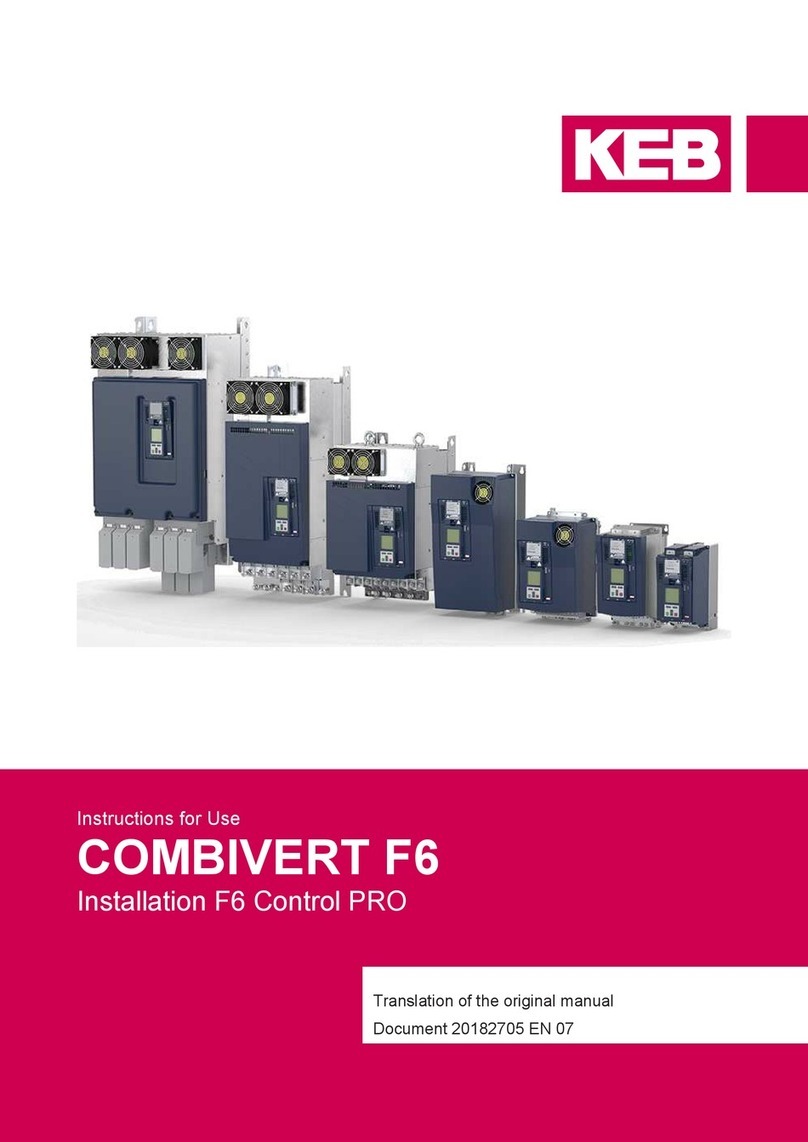
KEBCO
KEBCO COMBIVERT F6 Instructions for use
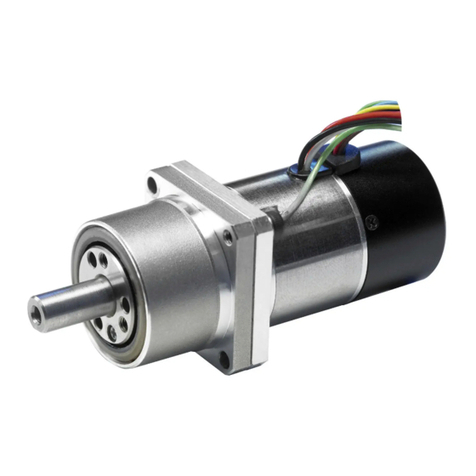
Harmonic Drive
Harmonic Drive RSF supermini Series manual
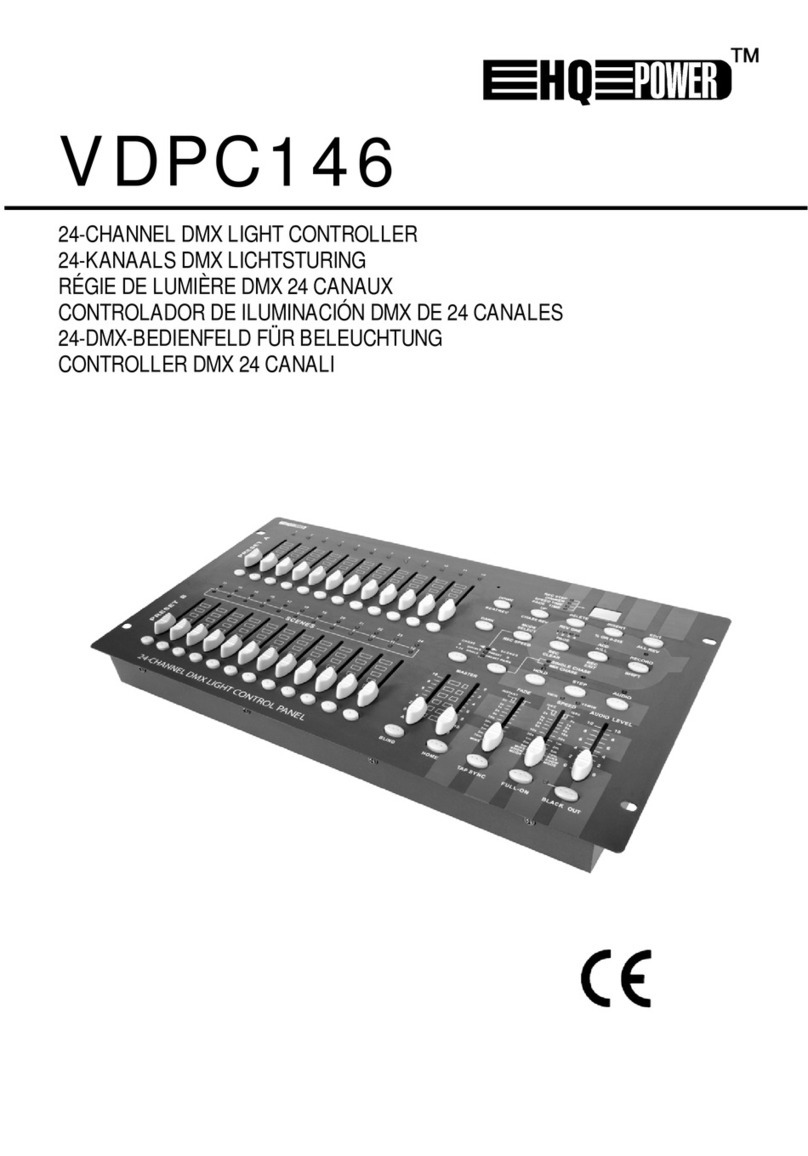
HQ Power
HQ Power VDPC146 user manual

United CoolAir
United CoolAir MARVEL MINI Installation, operation and maintenance manual
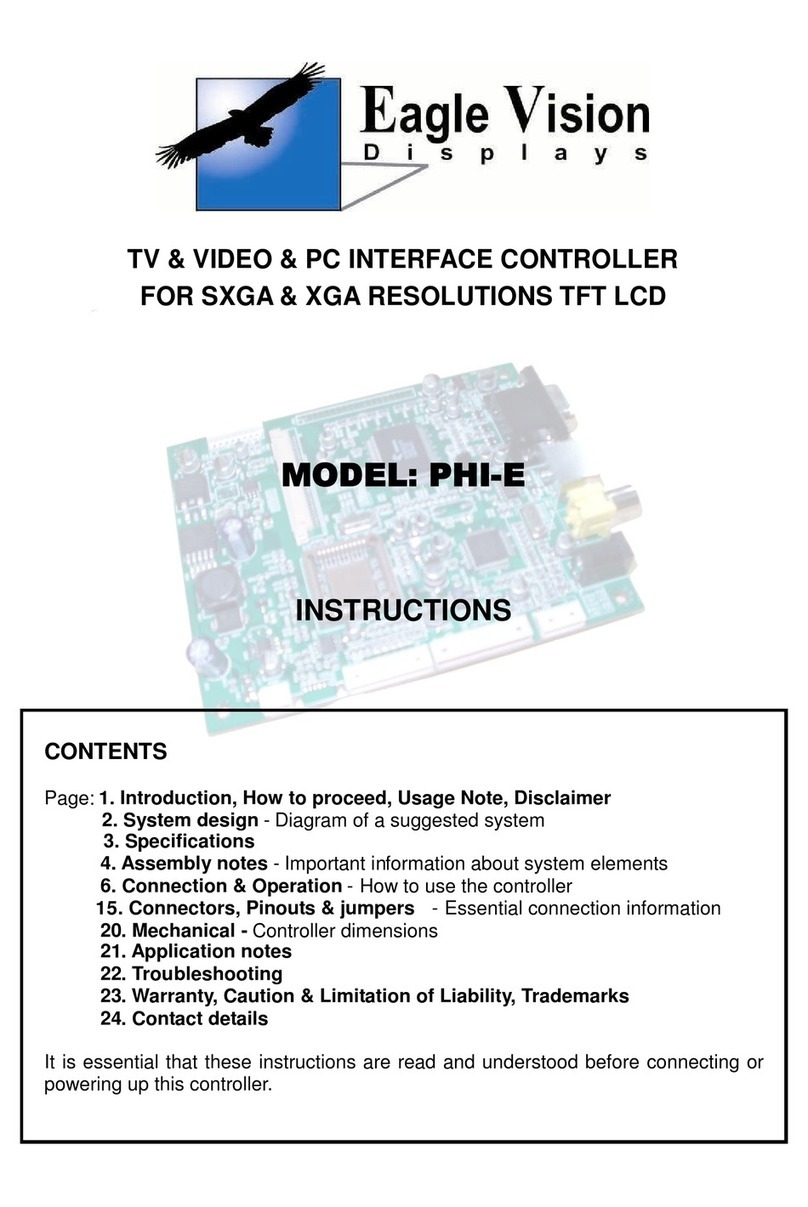
EagleVision
EagleVision PHI-E instructions

Alico
Alico YP5000 Series user manual


